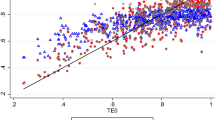Abstract
We consider a model that provides flexible parameterizations of the exogenous influences on inefficiency. In particular, we demonstrate the model's unique property of accommodating non-monotonic efficiency effect. With this non-monotonicity, production efficiency no longer increases or decreases monotonically with the exogenous influence; instead, the relationship can shifts within the sample. Our empirical example shows that variables can indeed have non-monotonic effects on efficiency. Furthermore, ignoring non-monotonicity is shown to yield an inferior estimation of the model, which sometimes results in opposite predictions concerning the data.
Similar content being viewed by others
References
Aigner, D., C. A. Knox Lovell and P. Schmidt. (1977). “Formulation and Estimation of Stochastic Frontier Production Function Models.” Journal of Econometrics 6, 21–37.
Barrow, D. F. and A. C. Cohen. (1954). “On Some Functions Involving Mill's Ratio.” Annals of Mathematical Statistics 25, 405–408.
Battese, G. E. and T. J. Coelli. (1995). “A Model for Technical Inefficiency Effects in a Stochastic Frontier Production Function for Panel Data.” Empirical Economics 20, 325–332.
Bauer, P. W. (1990). “Recent Developments in the Econometric Estimation of Stochastic Frontiers.” Journal of Econometrics 46, 39–56.
Bera, A. K. and S. C. Sharma. (1999). “Estimating Production Uncertainty in Stochastic Frontier Production Function Models.” Journal of Productivity Analysis 12, 187–210.
Caudill, S. B. and J. M. Ford. (1993). “Biases in Frontier Estimation Due to Heteroscedasticity.” Economics Letters 41, 17–20.
Caudill, S. B., J. M. Ford and D. M. Gropper. (1995). “Frontier Estimation and Firm-Specific Inefficiency Measures in the Presence of Heteroscedasticity.” Journal of Business and Economic Statistics 13, 105–111.
Coelli, T. J. and G. E. Battese. (1996). “Identification of Factors which Influence the Technical Inefficiency of Indian Farmers.” Australian Journal of Agricultural Economics 40, 103–128.
Greene, W. H. (1993). “The Econometric Approach to Efficiency Analysis.” In Harold O. Fride, C. A. Knox Lovell and Shelton S. Schmidt (eds.), The Measurement of Productive Efficiency. New York, Oxford: Oxford University, pp. 68–119.
Hadi, A. S. (1994). “A Modification of a Method for the Detection of Outliers in Multivariate Samples.” Journal of the Royal Statistical Society, Series B 56, 393–396.
Hadri, K. (1999). “Estimation of a Doubly Heteroscedastic Stochastic Frontier Cost Function.” Journal of Business and Economic Statistics 17, 359–363.
Huang, C. J. and J. T. Liu. (1994). “Estimation of a Non-Neutral Stochastic Frontier Production Function.” Journal of Productivity Analysis 5, 171–180.
Kumbhakar, S. C. and C. A. K. Lovell. (2000). Stochastic Frontier Analysis. Cambridge (England), New York: Cambridge University Press.
Kumbhakar, S. C., S. Ghosh and J. T. McGuckin. (1991). “A Generalized Production Frontier Approach for Estimating Determinants of Inefficiency in U.S. Dairy Farms.” Journal of Business and Economic Statistics 9, 279–286.
Meeusen, W. and J. van den Broeck. (1977). “Technical Efficiency and Dimension of the Firm: Some Results on the Use of Frontier Production Functions.” Empirical Economics 2, 109–122.
Schmidt, P. and H. J. Wang. (2002). “One-Step and Two-Step Estimation of the Effects of Exogenous Variables on Technical Efficiency Levels.” Journal of Productivity Analysis 18, 129–144.
Author information
Authors and Affiliations
Rights and permissions
About this article
Cite this article
Wang, HJ. Heteroscedasticity and Non-Monotonic Efficiency Effects of a Stochastic Frontier Model. Journal of Productivity Analysis 18, 241–253 (2002). https://doi.org/10.1023/A:1020638827640
Issue Date:
DOI: https://doi.org/10.1023/A:1020638827640




